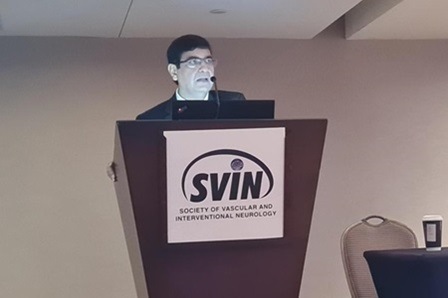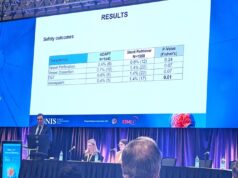
Fresh data from the SOFAST study have indicated high rates of technical success and first-pass reperfusion with the Sofia 6Fr Flow Plus aspiration catheter (Microvention/Terumo), indicating that the device is both safe and effective in large vessel occlusion (LVO) acute ischaemic stroke patients.
In his presentation of SOFAST’s results at the Society of Vascular and Interventional Neurology (SVIN) annual meeting (16–18 November 2023, Miami, USA), Dheeraj Gandhi (University of Maryland School of Medicine, Baltimore, USA) initially reported that Sofia is a “very atraumatic and flexible” aspiration catheter technology that allows operators to safely navigate through tortuous anatomies “with ease”.
The prospective, multicentre, single-arm, observational, post-market SOFAST study attempted to evaluate the device further as a first-line treatment option in suitable LVO stroke patients, with a total of 108 participants being enrolled across 13 global sites.
“When we look at first-line aspiration treatment with the Sofia catheter alone [in SOFAST], a remarkable 87% of patients had mTICI [modified thrombolysis in cerebral infarction] ≥2b revascularisation status at the end of the procedure, 79.6% had mTICI ≥2c, and 52.8% had an mTICI score of 3,” Gandhi reported, outlining the findings of the study’s primary effectiveness endpoint. “And, just looking at first-pass rates with the Sofia catheter alone, 70.4% of patients had a first-pass effect [mTICI ≥2c], and 75% had a modified first-pass effect—meaning an mTICI score of 2b or better.”
The speaker went on to relay that, at the end of all the procedures in the study—including following the use of adjunctive devices—97.2% achieved an outcome of mTICI ≥2b, 85.2% achieved mTICI ≥2c, and 55.6% achieved mTICI 3. Another finding Gandhi highlighted was that, across the whole study, the majority of all patients who achieved mTICI 3 did so following a single pass with the Sofia catheter alone (50.9%).
In addition, this iteration of the Sofia catheter “remarkably” demonstrated a 0% rate of embolisation to new territories (ENT)—a secondary outcome measure that compares “very favourably” with previously published study data.
Regarding clinical outcomes, Gandhi reported that roughly two thirds (66.7%) of patients experienced a good functional outcome, achieving a score of 2 or less on the modified Rankin scale (mRS) at 90 days. There were also no major safety concerns, he continued, with 9.3% of cases demonstrating variable degrees of vasospasm—none of which were symptomatic or required treatment—as well as 90-day mortality and symptomatic intracranial haemorrhage (sICH) rates of 7.4% and 0.9%, respectively.
In addition to reemphasising the fact that these results indicate the Sofia 6Fr Flow Plus catheter is a safe and effective approach to aspiration thrombectomy in patients with acute ischaemic stroke secondary to an LVO, the speaker concluded by noting that the device was associated with particularly short median times for both clot engagement (12 minutes) and recanalisation (17 minutes).
A discussion directly following Gandhi’s presentation at SVIN saw session moderator Pascal Jabbour (Thomas Jefferson University Hospital, Philadelphia, USA) note that the findings of this study suggest that the latest, most expensive technologies are “not always the answer”, as the Sofia catheter has been around for 10 years but is still producing leading outcomes in the neurointerventional space.









